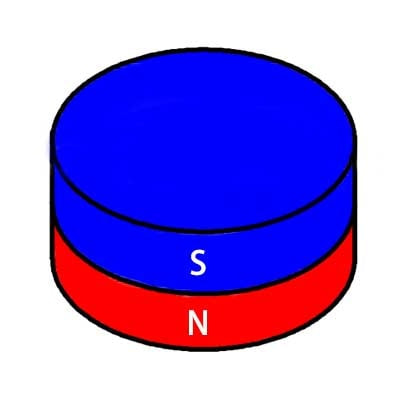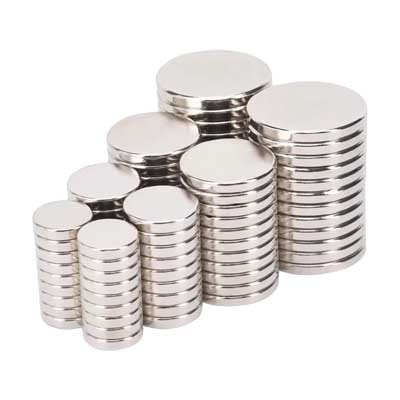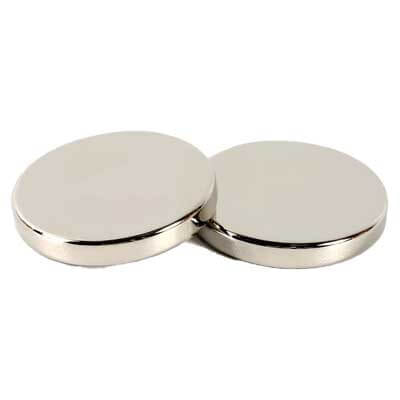There are three main components playing important roles on magnetic properties for strong magnets: magnetic strength, energy product, and coercivity. They are the most critical factors for selecting the right magnet on a specific application of your own.
Comparison of the Three Properties
| Property | Definition | Units | Importance | Example Values |
|---|---|---|---|---|
| Magnetic Strength (Br) | Residual magnetic flux density |
Gauss (G), Tesla (T) |
Determines the strength of the magnetic field | NdFeB: 1.0–1.4 T |
| Energy Product (BHmax) | Maximum energy density | MGOe, kJ/m³ | Indicates efficiency and compactness |
NdFeB: Up to 52 MGOe* |
| Coercivity (Hc) | Resistance to demagnetization | Oersteds (Oe), A/m | Ensures stability under adverse conditions | SmCo: High coercivity |
*52 MGOe (Mega Gauss Oersted) is N52 magnets' properties, which is the strongest grade of rare earth permanent magnets.
(1) Magnetic Strength (Remanence, Br)
Magnetic strength, also known as remanence (Br), is the magnetic induction or magnetization that remains in a ferromagnetic material after an external magnetic field has been applied and then removed. It is measured in gauss (Gs) or tesla (T). In other words, it is the "leftover" magnetization of a magnet when the external field is no longer present. The higher the remanence, the stronger the retained magnetic induction strength of the material, and the greater its potential to be a strong magnet.
Units:
-
Gauss (G) or Tesla (T) in the CGS and SI systems(International System of Units), respectively.
-
Conversion: 1 Tesla = 10,000 Gauss.
Applications:
-
High remanence is crucial for applications requiring strong magnetic fields, such as electric motors, speakers, and MRI machines.
(2) Energy Product (BHmax)
The energy product (BHmax) represents the maximum energy density a magnet can store. It is the product of the magnetic induction (B) and the magnetic field strength (H) at any point on the demagnetization curve. The maximum value of this product is called the maximum energy product, denoted as (BHmax). The higher the BHmax, the more energy-efficient the magnet is in a small size, and the better its ability to produce a magnetic field in practical applications. In theory, (BHmax) equals ½ Br² .
Units:
-
Mega-Gauss-Oersteds (MGOe) in the CGS system or KiloJoules per cubic meter (kJ/m³) in the SI system.
-
Conversion: 1 MGOe = 7.96 kJ/m³.
Applications:
-
High-energy product magnets are used in compact devices like headphones, hard drives, and electric vehicle motors.
(3) Coercivity (Hc)
Coercivity (Hc), also known as magnetic coercivity, coercive field, or coercive force, measures a magnet's resistance to demagnetization from an external magnetic field. It is the intensity of the reverse magnetic field required to reduce the material's magnetization to zero. High coercivity ensures the magnet retains its magnetic properties under adverse conditions (e.g., high temperatures or external fields).
Normally there are two types of coercivity:
-
Intrinsic Coercivity (Hcj): Resistance to demagnetization from internal factors.
-
Coercive Force (Hcb): Resistance to demagnetization from external fields.
Units:
-
Oersteds (Oe) in the CGS system or Amperes per meter (A/m) in the SI system.
-
Conversion: 1 Oe = 79.6 A/m.
Applications:
-
Magnets with high coercivity are used in environments with strong external fields or elevated temperatures, such as aerospace and military applications.




 Customized is available
Customized is available T/T or L/C accepted
T/T or L/C accepted EXW/FOB/CIF/DDU first
EXW/FOB/CIF/DDU first 24 hours customer services
24 hours customer services Offer free magnetic solution
Offer free magnetic solution Quality guaranteed
Quality guaranteed 3~20 days lead time
3~20 days lead time Free samples provided
Free samples provided 100% secured online ordering
100% secured online ordering



